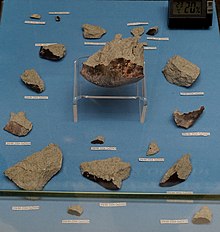Braunschweig meteorite
| Braunschweig | |
|---|---|
 Fragments of the meteorite at the State Natural History Museum, Braunschweig | |
| Type | Chondrite |
| Class | Ordinary chondrite |
| Group | L6 |
| Shock stage | S4 |
| Weathering grade | W0 (pristine) |
| Country | Germany |
| Region | Lower Saxony |
| Coordinates | 52°13′33″N 10°31′12″E / 52.22583°N 10.52000°ECoordinates: 52°13′33″N 10°31′12″E / 52.22583°N 10.52000°E |
| Observed fall | Yes |
| Fall date | April 23, 2013, 02:05 CET (UTC+01:00) |
| Found date | April 23, 2013 |
| TKW | 1.3 kg (2.9 lb) |
The Braunschweig meteorite is a 1.3 kilograms (2.9 pounds) meteorite that hit Melverode, a suburb in Braunschweig, Germany, at around 2:05 AM on April 23, 2013. It hit the concrete pavement in front of the home of Erhard Seemann, breaking into hundreds of fragments on impact, the largest of which is 214 grams (0.472 pounds). The meteorite created a small impact crater in the concrete, with a diameter of 7 cm (2.8 in) and a depth of 3 cm (1.2 in).[1][2]
Composition and classification[]
The meteorite has been classified as an L6 ordinary chondrite.[1]
Impact[]
The meteorite fell at around 2:05 AM on April 23, 2013, with an estimated velocity of 250 km/h (160 mph). It hit concrete pavement 3 m (9.8 ft) from Erhard Seemann's front door, breaking into hundreds of fragments upon impact. The largest fragment, with a mass of 214 grams, stuck in the concrete, forming an impact crater with a diameter of 7 cm (2.8 in) and a depth of 3 cm (1.2 in). Fragments of concrete ejected from the impact were as wide as 5 cm (2.0 in). Many other fragments of the meteorite were found within 18 m (59 ft) from the impact crater by several people.[2][3] Traces of a secondary impact were found at a nearby brick wall in the form of indents 1 cm (0.39 in) wide. A total of 1.3 kg (2.9 lb) of fragments were found.[2]

Reports[]
A neighbor reported hearing a strong hum and "whoosh" followed by a loud crash at around 2:10 AM, who then found four fragments of the meteorite on his driveway. In Ahlum, 8 km (5.0 mi) from the impact site, Julian Mascow reported a bright flare approaching from the southeast for 1–2 seconds, with a luminosity "like dawn," before ending in a "short tracer just over his head." He heard a loud explosion about 90 seconds later followed by a rumbling noise. Mark Vornhusen's web camera documented the fireball from Vechta, located about 160 km (99 mi) from Braunschweig.[2][1] The light meter of a weather station in Brandenburg, approximately 240 km (150 mi) from Braunschweig, recorded 5 seconds of brightening. The Technical University of Braunschweig informed expert Rainer Bartoschewitz of the reports, who inspected the site on April 27 and confirmed the meteorite.[2]
References[]
- ^ a b c "Braunschweig". Lunar and Planetary Institute. Retrieved January 8, 2020.
- ^ a b c d e Bartoschewitz, Rainer; Appel, Peter; Barrat, Jean-Alix; Bischoff, Addi; Caffee, Marc W.; Franchi, Ian A.; Gabelica, Zelimir; Greenwood, Richard C.; Harir, Mourad; Harries, Dennis; Hochleitner, Rupert; Hopp, Jens; Laubenstein, Matthias; Mader, Barbara; Marques, Rosa; Morlok, Andreas; Nolze, Gert; Prudêncio, Maria Isabel; Rochette, Pierre; Ruf, Alexander; Schmitt-Kopplin, Philippe; Seemann, Erhard; Szurgot, Marian; Tagle, Roald; Wach, Radosław A.; Welten, Kees C.; Weyrauch, Mona; Wimmer, Karl (April 2017). "The Braunschweig meteorite − a recent L6 chondrite fall in Germany". Geochemistry. 77 (1): 207–224. Bibcode:2017ChEG...77..207B. doi:10.1016/j.chemer.2016.10.004. Retrieved January 8, 2020.
- ^ "Braunschweig meteorite, Brunswick, Lower Saxony, Germany". Mindat.org. Retrieved January 8, 2020.
External links[]
- Richard Greenwood (November 28, 2016). "The World's Smallest Meteorite Crater?". meteoritestheblog.com. Retrieved January 12, 2016.
- Meteorites by name
- Chondrite meteorites
- Meteorite falls
- 2013 in Germany
- April 2013 events in Europe
- Meteorites found in Germany
- Events in Lower Saxony
- 2010s in Lower Saxony
- Braunschweig
- 2013 in space
